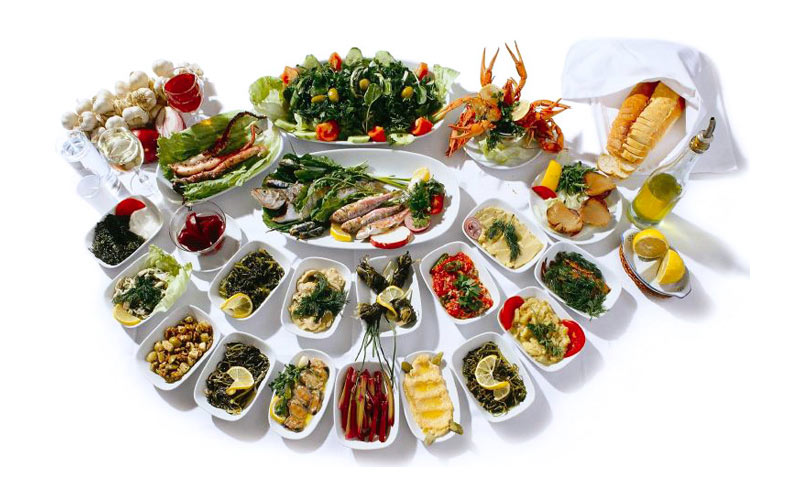Cyprus wines, famous since ancient times, are more than maintaining their tradition by becoming increasingly competitive in the International market. The quality of Cyprus table–wines features amongst the best in the world and the great variety provides a match for every kind of food and every plate.
Moreover, eating out to catch some local flavour is always the high spot of the holiday, but where do you start when faced with the Cypriot menu at your local taverna?In the course of your stay it is quite possible to try everything and taste all the dishes at one sitting.
Meze is short for mezedhes, or little delicacies, and wherever you travel around the Mediterranean they appear in some form or another. Share a meze in Cyprus and you have tasted the true flavours of the island, for you may be served anything up to 30 dishes. It is a complete meal, but beware, don't be tempted to finish every dish that arrives on the table, or you may feel as though you' ve eaten for a week by the end. Just take a leaf out of a Cypriot's book and enjoy your meze 'siga siga' or slowly slowly.
Well, the decision has be made and your meze is ordered - what can you expect to eat? First come the olives, black and green (elies) tsakistes with a dressing of lemon, garlic, herbs, coriander seeds and oil.
Dips of tahini, skordalia, taramosalata, and talattouri arrive with a basket of fresh village bread and a bowl of salata horiatiki or village salad.
Octapodi krasato (octopus in red wine), karaoli yahni (snails in tomato sauce), zelatina, prawn and pickles of capers, kappari and pickled cauliflower, moungra, are some of the unusual meze dishes that may arrive next.
Bunches of greens, some raw, some dressed with lemon juice and salt such as carrots and kohlrabi, and some tossed in oil and bound with egg may also fit into your meze. Fish of some kind could be next on the menu. Marida, tiny sardine type fish or barbouni, red mullet which are usually served very small, and kalamari or rings of squid buttered and deep fried, accompanied with chunks of fresh lemon.
Grilled halloumi cheese and lountza, smoked pork, come next followed by keftedes (meat balls), the popular sheftalia, grilled pork (brissoles) and loukanika, smoked Cyprus sausages.
Now it's time for the composite dishes of casseroles such as afelia, moussaka and stifado.
Towards the end of the meal come the kebabs or souvlakia, the ofto kleftiko (meat baked in a sealed oven), as well as pieces of chicken, arriving straight from the grill.
But perhaps you are beginning to feel full now... No surprise - you've survived your first meze!
Sit back content in the knowledge that little else is to follow. Just some fresh fruit, carefully prepared and segmented and, well, perhaps just a few sugar dredged bourekia pastry filled with fresh curd cheese and honey.
The cultivation of vines for dessert fruit and wine is relatively recent, the grape first having been cultivated in the Black Sea area around 8,000 years ago. From there it spread slowly south-eastwards to Mesopotamia, Syria and Egypt, from where it travelled across the Mediterranean to Greece, on to Italy, and so on. Settlers from the mainland coast to the east came to Cyprus 4,000 years ago and, although there is no firm evidence to prove it, it is virtually certain they would have brought their wine-producing vines with them. When the Greeks settled in Cyprus around 1200 B.C., it is likely they would have found wine already here, but of a very different style to the wines they were accustomed to. Thus, it is likely that there has been a wine industry in Cyprus continuously longer than anywhere else in the world.
Facts are supported by legend and ancient history. The Song of Solomon praises Cyprus wines. In 800 B.C., Hesiodos described the making of Cyprus wines. The Greek poet Euripides writes of vast pilgrimages to Cyprus to taste the wine, or as it was then known "Cyprus Nama". Legend has it that the first mortal to be taught to make wine was Ikarios, whose teacher was Dionysos, the god of wine himself. The scene is, in fact, depicted in a mosaic in the House of Dionysos in Pafos where other wine related scenes are also shown. Further archaeological evidence of viticulture and winemaking can be seen in museums and around the island.
Approximate cost for a bottle of Cyprus wine of 0,75 litre in a restaurant or a taverna: from € 8.00.
